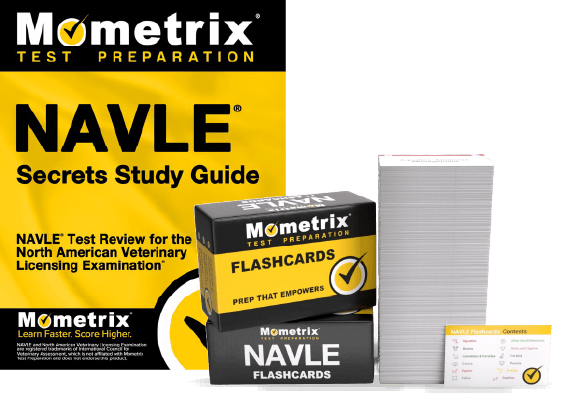If you need help studying for the NAVLE® exam or just want some more information about what the test is like, you’ve come to the right place.
Click below to take a free NAVLE practice test!
What’s on the Exam?
How to Register
Exam Scores
Retaking the Exam
Online NAVLE Prep Course
FAQs
Exam Eligibility
Before you can register to take the NAVLE exam, you need to be enrolled in (or a graduate of) an AVMA-accredited vet school and the ECFVG or PAVE.
If you meet these requirements, you’re set to begin the registration process!
What’s on the Exam?
First, let’s talk about the questions on the exam. There are 360 multiple-choice questions total, but only 300 of the questions will count toward your score. Why is that?
The 60 unscored questions on the NAVLE exam are called “pretest” questions. These are added to the exam to determine if they’re good enough questions to add to future versions of the test.
The trick is that you won’t have any way of knowing which questions are scored and which ones are pretest. They will appear just like the scored questions throughout the test.
The time limit for the exam is 6.5 hours, which is split into six blocks of 65 minutes each. Each block contains exactly 60 questions.
Let’s take a closer look at each section of the exam.
1. Clinical Practice
70% of the exam
- Prioritizing diagnostic procedures based on available resources
- Obtaining specimens or samples for lab studies
- Interpreting diagnostic images
- Reading and interpreting farm-based computer reports or production records to understand herd-level health parameters
- Reviewing animal medical records to determine health status
- Investigating possible exposure of companion animals to toxins
- Creating or updating medical records
- Observing and interpreting an animal’s mental status and behavior
- Developing a differential diagnosis
- Obtaining animal health history from clients
- Formulating a diagnostic plan
- Performing general physical examinations
- Performing postmortem examinations to determine cause of death
- Formulating possible differential diagnoses
- Interpreting findings from physical examinations
- Interpreting findings from laboratory tests
- Performing system-specific examinations
- Interpreting cytologic specimens
- Investigating possible exposure of food or game animals to toxins
- Interpreting principles of pathophysiology and mechanisms of action
- Interpreting findings from postmortem specimens
- Obtaining diagnostic images
- Performing standard diagnostic tests on samples
- Interpreting results of system-specific examinations
Health Maintenance and Prevention (35%)
- Administering general anesthesia
- Applying a splint, cast, or other stabilization device
- Caring for wounds or surgical incisions
- Determining prognosis
- Evaluating a treatment outcome
- Establishing a rehabilitation plan
- Administering a biological or pharmacological agent other than anesthesia
- Establishing a treatment plan
- Formulating or evaluating a behavior modification plan
- Performing major surgical procedures
- Formulating patient/herd/population management and treatment plans
- Synthesizing multiple sources of diagnostic information, including local disease prevalence, to determine diagnosis
- Prescribing a biological or pharmacological agent
- Performing common therapeutic/surgical procedures
- Treating minor injuries or trauma
- Administering local anesthesia
- Referring clients to veterinary specialists for further diagnostic studies or treatment
2. Communication
8% of the exam
- Advising clients on health maintenance for herd, flock, or individual pets
- Discussing euthanasia with clients
- Explaining diagnosis and prognosis to clients in lay terminology
- Teaching clients about preventive care
- Ensuring clients understand the effects of prescribed pharmaceuticals
- Providing verbal instructions regarding follow-up care
- Obtaining informed consent from clients
- Explaining research results to clients and their implications for animal care
- Talking with clients to clarify concerns and expectations regarding care
- Advising clients regarding appropriate and inappropriate pharmacy compounding
- Discussing strategies to reduce antibiotic resistance and antibiotic residues with clients or producers
- Recommending management options that align with clients’ cultural norms and values
- Informing clients of bad news
- Instructing clients on methods for isolating and quarantining diseased animals
- Negotiating payment plans with clients
- Helping clients differentiate trustworthy from unreliable information
- Writing summaries of animal care instructions for clients
- Using appropriate communication techniques
- Referring clients for grief counseling
- Providing instruction regarding food safety practices
- Discussing the limits of legal extra-label drug use with clients
- Instructing clients on obtaining diagnostic information from an animal’s home environment
Communication with Veterinary and other Professionals (3%)
- Mentoring and supervising veterinary and veterinary technician students
- Delivering verbal case summaries to other veterinarians or health care team members
- Building relationships with junior colleagues or new graduates
- Training staff in animal health and care
- Writing case summaries for use by other veterinarians or health care team members
- Guiding the work of associates or staff in the delivery of veterinary services
- Explaining research results to non-veterinary health workers
- Consulting with other veterinarians or veterinary specialists regarding animal care
- Delegating delivery of veterinary care and services to associates or staff
- Responding to unprofessional or unethical behavior in others
- Engaging regulatory bodies to improve standards of practice or address professional issues
- Describing disaster preparedness plans to coworkers
3. Professionalism, Practice Management, and Wellness
7% of the exam
- Attending training on emerging technologies in veterinary medicine
- Encouraging wellness among veterinarians and support staff
- Consulting reference materials to formulate diagnosis or treatment options
- Conducting oneself in a professional, ethical, and legal manner
- Reading journal articles for professional development
- Exchanging new scientific or technical information with other health professionals
- Giving talks at professional meetings
- Participating in professional development activities
- Attending professional development seminars or workshops
- Participating in online professional development activities
- Participating in activities of local, national, or international professional associations
- Participating in or conducting investigations to test new procedures
Veterinary Practice Management (4%)
- Applying appropriate animal restraint
- Evaluating and purchasing major medical equipment
- Developing a budget for own practice or employer
- Preparing or updating the employee handbook
- Supervising paraprofessional or technical support staff
- Describing the workings of benefit plans to staff
- Purchasing expendable supplies
- Evaluating and purchasing office/practice management software
- Developing standard operating procedures
- Evaluating new medications, products, or treatment procedures for suitability in practice
- Negotiating work or practice arrangements with colleagues
- Reviewing practice management data, including business and financial records
4. Preventive Medicine and Animal Welfare
15% of the exam
- Applying isolation or quarantine and disinfection measures to the work environment for disease prevention or control
- Ensuring proper disposal of biomedical waste
- Evaluating animal environments to identify epidemiological problems and public health concerns
- Inspecting the practice environment to ensure safety and accessibility
- Informing clients or the community about effective methods for managing animal or human waste
- Instructing staff, colleagues, or others on proper techniques for biomedical waste disposal
- Monitoring the workplace to ensure compliance with hazardous materials requirements
- Instructing clients on humane methods to terminate diseased animals and dispose of infected carcasses
Veterinary Public Health (4%)
- Applying isolation or quarantine procedures for disease prevention and control
- Collaborating or consulting with clients, health professionals, government agencies, or community groups on public health issues like food safety and zoonotic diseases
- Investigating disease outbreaks
- Formulating patient or herd management and treatment plans for public health or zoonotic disease cases
- Participating in disease control or eradication programs
- Inspecting food to ensure consumer safety
- Reporting transboundary or zoonotic diseases to state, regional, or national agencies
- Conducting community education workshops on topics related to animal or human health
- Participating in epidemiologic inquiries of reportable diseases by collecting, handling, or transporting specimens
- Consulting with community stakeholders about animal population control
- Discussing animal care options with immunocompromised owners
- Informing clients or the community about prevention and treatment of zoonotic organism exposure
Animal Welfare Issues and Concerns (6%)
- Conducting periodic or annual examinations on client animals and discussing vaccination, deworming, diet, exercise, and other wellness considerations
- Verifying that diseased or infected animals have been managed according to professional or governmental guidelines
- Explaining the components of an animal welfare audit to clients
- Identifying and taking action on animal welfare problems
- Certifying that animals or animal products meet certain standards
- Conducting or overseeing an animal welfare audit
- Working with community groups or regulatory bodies to address the ethical treatment, health, and welfare of animals
How to Register
Once you’ve ensured that you meet all of the eligibility requirements, you can register for the exam!
To get started, you’ll need to submit an application on ICVA’s website. The application will ask you for your contact information and any documentation to prove your eligibility (among other things).
Exam Scores
The test is scored using a scaled scoring method. Here’s how it works:
For every question you answer correctly, you get one point added to your raw score. At the end of the test, your final raw score will be converted to a scaled score. This scaled score will range somewhere between 200 and 800.
The reason your raw score is converted to a scaled score is because everyone who takes the NAVLE test is given a slightly different set of questions. Since everyone has a different arrangement of questions, and because some questions are harder than others, converting your raw score to a scaled score ensures a more even playing field.
Your score report will show you where your score lands in relation to the passing score, as well as other recent test-takers’ scores:
Retaking the Exam
If you didn’t get a passing score on your first try, that’s okay! You can retake the test up to four more times.
Keep in mind that you will have to pay the full testing fee every time you retake the test.
Online NAVLE Prep Course
If you want to be fully prepared, Mometrix offers an online NAVLE prep course. The course is designed to provide you with any and every resource you might want while studying. The NAVLE course includes:
The NAVLE prep course is designed to help any learner get everything they need to prepare for their NAVLE exam. Click below to check it out!
FAQs
How many questions are on the NAVLE?
The exam contains 360 questions.
When are NAVLE scores released?
You should receive your NAVLE score 4-5 weeks after you take the exam.
How long is the NAVLE?
The exam is timed at 6.5 hours.
How many times can you take the NAVLE?
You can take the test up to 5 times. If you still haven’t passed after the fifth attempt, you’ll need to get special permission to take it again.
What is the passing score for the NAVLE?
You’ll need to get a final scaled score of at least 425 to pass.
How much does the NAVLE cost?
The exam fee is $800.
NAVLE and North American Veterinary Licensing Examination are registered trademarks of International Council for Veterinary Assessment, which is not affiliated with Mometrix Test Preparation and does not endorse this page.



 NAVLE Online Course
NAVLE Online Course NAVLE Study Guide
NAVLE Study Guide NAVLE Flashcards
NAVLE Flashcards


